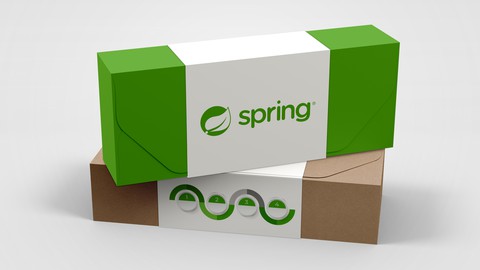
Master Spring Batch (based on Spring Boot)
Master Spring Batch (based on Spring Boot), available at $199.99, has an average rating of 4.25, with 80 lectures, based on 139 reviews, and has 1118 subscribers.
You will learn about Spring Batch in complete Java configuration based on Spring Boot Setting up a simple Spring Batch job Developing a complete Spring Batch application Data processing with Reader, Writer, Processor – Performance optimization through parallelization Fault tolerance and error handling Parameter Validation Several ways to save states Control flows Evaluate jobs – How to develop the backend for a custom administration interface The Spring Batch Data Model Test Batch Jobs How to simulate parts of a batch job with mock objects This course is ideal for individuals who are Software developers with professional experience who want to develop professional batch applications or Developers who are interested in performance optimization. It is particularly useful for Software developers with professional experience who want to develop professional batch applications or Developers who are interested in performance optimization.
Enroll now: Master Spring Batch (based on Spring Boot)
Summary
Title: Master Spring Batch (based on Spring Boot)
Price: $199.99
Average Rating: 4.25
Number of Lectures: 80
Number of Published Lectures: 80
Number of Curriculum Items: 80
Number of Published Curriculum Objects: 80
Original Price: $199.99
Quality Status: approved
Status: Live
What You Will Learn
- Spring Batch in complete Java configuration based on Spring Boot
- Setting up a simple Spring Batch job
- Developing a complete Spring Batch application
- Data processing with Reader, Writer, Processor – Performance optimization through parallelization
- Fault tolerance and error handling
- Parameter Validation
- Several ways to save states
- Control flows
- Evaluate jobs – How to develop the backend for a custom administration interface
- The Spring Batch Data Model
- Test Batch Jobs
- How to simulate parts of a batch job with mock objects
Who Should Attend
- Software developers with professional experience who want to develop professional batch applications
- Developers who are interested in performance optimization.
Target Audiences
- Software developers with professional experience who want to develop professional batch applications
- Developers who are interested in performance optimization.
Spring Batch is one of the many excellent tools from the Spring Framework. Unfortunately, it is rarely used. One reason may be that the learning curve at the beginning is a little steeper than with the usual Spring. As an example, a simple Hello World application will easily fill a screen page. But this first hurdle should not stop you from learning this framework. Once you have modeled your data processing with Spring Batch, you will have countless optimization possibilities at your disposal. Everyone who has ever dealt with serious batch processing will sooner or later encounter the problems that this framework has already solved. For me, the greatest problem of concern is state handling and error analysis. Proper maintenance is much more difficult than you might think at first. A long-running process, which executes all tasks one after the other might function well and has no problems. But when interruptions, repetitions, parallelism, or asynchronous calls are added, then the greatest effort of thought is required to build a stable solution. In cases where errors occur in live operation and need to be solved immediately, you would need a good tool to deliver corrections quickly.
For this course, I worked through the latest documentation and programmed several practical examples based on it. I will show you the individual features step by step in small unit tests, with which you can learn everything experimentally on your own. Using practical examples, you will learn how everything is connected. Everything I teach here is something that I implement in my day-to-day work. My colleagues and I have high standards for the quality of our work. I also try to incorporate this aspect into the structure of the source texts for this course, so that you can learn practical examples.
Course Curriculum
Chapter 1: Introduction and Setup
Lecture 1: Why should you use Spring Batch?
Lecture 2: Where to find the source code
Lecture 3: Project import explained
Chapter 2: Your first spring batch job
Lecture 1: Hello Spring Batch
Lecture 2: Definition of terms
Lecture 3: The first spring batch application as service
Lecture 4: Uniqueness of parameters
Lecture 5: Auto-Configuration
Lecture 6: Spring initializr
Lecture 7: Multiple job configurations in one application
Chapter 3: Item Reader, Writer, Processor
Lecture 1: Reader / Processor / Writer Introduction
Lecture 2: Implement a reader
Lecture 3: Implement a writer
Lecture 4: Solution to the generics problem
Lecture 5: Implement a processor
Chapter 4: Scopes
Lecture 1: StepScope – Recreate step beans on every job start
Lecture 2: Scoped beans without passing NULL
Lecture 3: StepScope – A closer look
Lecture 4: StepScope & Proxies – How Spring creates Beans on the fly.
Lecture 5: JobScope – Create step beans at runtime
Chapter 5: Chunks
Lecture 1: How the chunk size effects the job processing
Lecture 2: Chunks and parallel processes
Chapter 6: Real life example
Lecture 1: Job components in multiple files
Lecture 2: Test complex jobs with partial mocking
Lecture 3: ItemStreamReader instead of ItemReader
Chapter 7: The data model
Lecture 1: Advantages of the persistent data model
Lecture 2: Schema documentation
Lecture 3: Schema, Scripts and Migration explained
Lecture 4: Unique identifiers and keys
Lecture 5: Log Job Summary with Listener
Lecture 6: Role of the jobrepository
Lecture 7: Store your own information in the data model
Chapter 8: Listener
Lecture 1: A simple job execution listener
Lecture 2: Job execution listener as component
Lecture 3: Thread safety for the job execution listener
Lecture 4: StepExcecutionListener and Tasklet combined
Lecture 5: Listener with Annotations
Chapter 9: Scheduling
Lecture 1: How to schedule jobs
Lecture 2: Advanced scheduling
Chapter 10: Validation and fault tolerance
Lecture 1: A simple parameter validator
Lecture 2: Default parameter validator from spring batch
Lecture 3: Filter values in a processor
Lecture 4: Fault tolerance for certain exceptions
Chapter 11: Practice Project One – A job server for data anonymisation
Lecture 1: Project introduction
Lecture 2: Project setup
Lecture 3: Download and project overview
Lecture 4: Initial configuration of the job
Lecture 5: Implement the first unit test
Lecture 6: Complete the job configuration
Lecture 7: Reader and Writer
Lecture 8: Filter persons with the processor
Lecture 9: Validate parameters
Lecture 10: Upload trigger
Lecture 11: Upload watch alternatives
Lecture 12: JobExecutionListener Part 1
Lecture 13: JobExecutionListener Part 2
Lecture 14: Your task – Anonymize the input data!
Lecture 15: Solution – How the input data is anonymized
Lecture 16: Finish the project and summarize
Chapter 12: Customize step control flow
Lecture 1: How to implement batch flows
Lecture 2: Add custom control parameters to flows
Chapter 13: Practice project two – flight search engine
Lecture 1: Scenario
Lecture 2: Search page Introduction
Lecture 3: Source code
Lecture 4: Import project
Lecture 5: Test for the first special offer
Lecture 6: Your task, implement the provider decider
Lecture 7: Solution for the provider decider
Lecture 8: Create a new flow
Lecture 9: Second task, implement the other special offer
Lecture 10: Fault tolerance
Lecture 11: Parallel flows
Chapter 14: Practice project three – visualize running jobs
Lecture 1: Preview
Lecture 2: Download the source code
Lecture 3: Import project
Lecture 4: List all job definitions
Lecture 5: Instances and executions
Lecture 6: Trigger a job via controller
Lecture 7: Start and stop
Lecture 8: End result
Instructors
-

Christian Oette
Software developer
Rating Distribution
- 1 stars: 5 votes
- 2 stars: 2 votes
- 3 stars: 15 votes
- 4 stars: 47 votes
- 5 stars: 70 votes
Frequently Asked Questions
How long do I have access to the course materials?
You can view and review the lecture materials indefinitely, like an on-demand channel.
Can I take my courses with me wherever I go?
Definitely! If you have an internet connection, courses on Udemy are available on any device at any time. If you don’t have an internet connection, some instructors also let their students download course lectures. That’s up to the instructor though, so make sure you get on their good side!
You may also like
- Digital Marketing Foundation Course
- Google Shopping Ads Digital Marketing Course
- Multi Cloud Infrastructure for beginners
- Master Lead Generation: Grow Subscribers & Sales with Popups
- Complete Copywriting System : write to sell with ease
- Product Positioning Masterclass: Unlock Market Traction
- How to Promote Your Webinar and Get More Attendees?
- Digital Marketing Courses
- Create music with Artificial Intelligence in this new market
- Create CONVERTING UGC Content So Brands Will Pay You More
- Podcast: The top 8 ways to monetize by Podcasting
- TikTok Marketing Mastery: Learn to Grow & Go Viral
- Free Digital Marketing Basics Course in Hindi
- MailChimp Free Mailing Lists: MailChimp Email Marketing
- Automate Digital Marketing & Social Media with Generative AI
- Google Ads MasterClass – All Advanced Features
- Online Course Creator: Create & Sell Online Courses Today!
- Introduction to SEO – Basic Principles of SEO
- Affiliate Marketing For Beginners: Go From Novice To Pro
- Effective Website Planning Made Simple




















